8.5 Chicago Rules
Latest Update: 2024 Feb 05
Originally posted: 2023 Aug 05
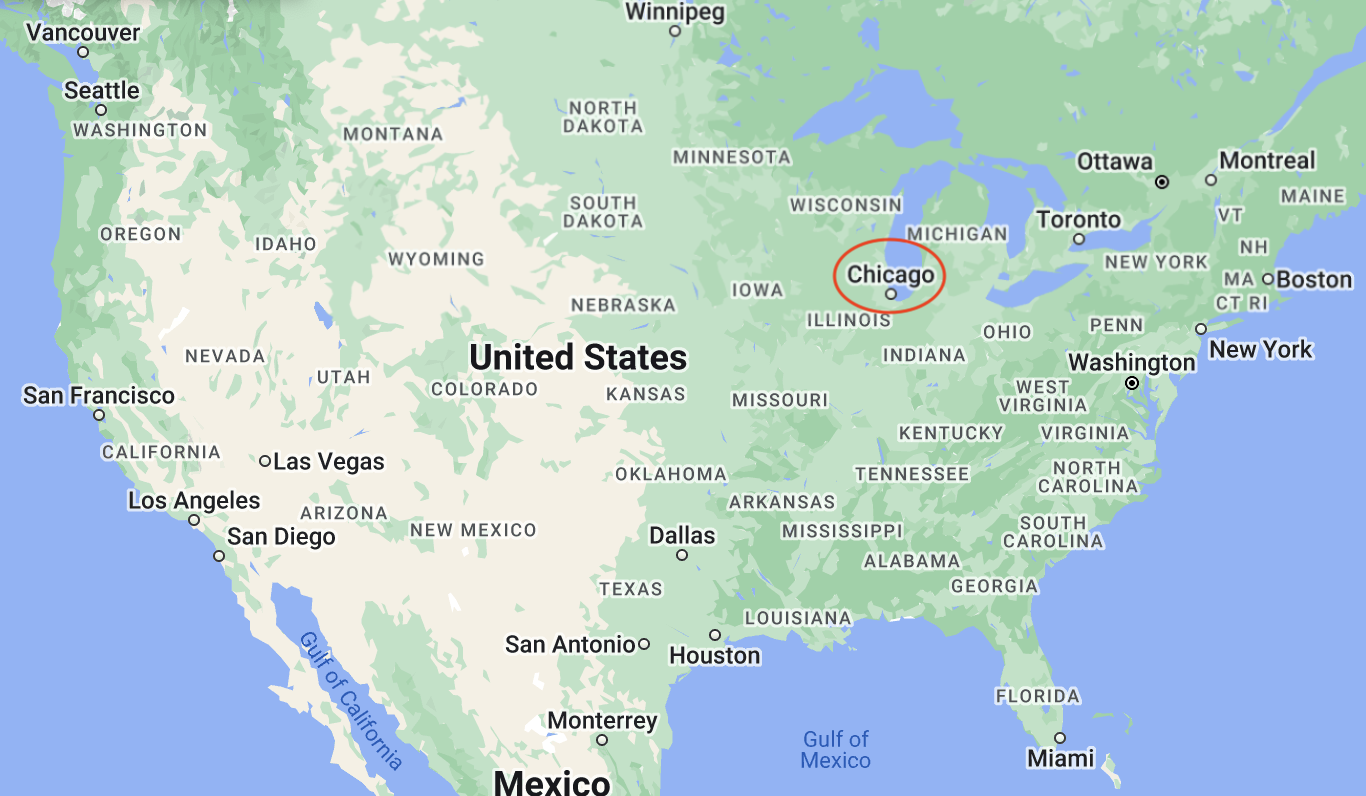 |
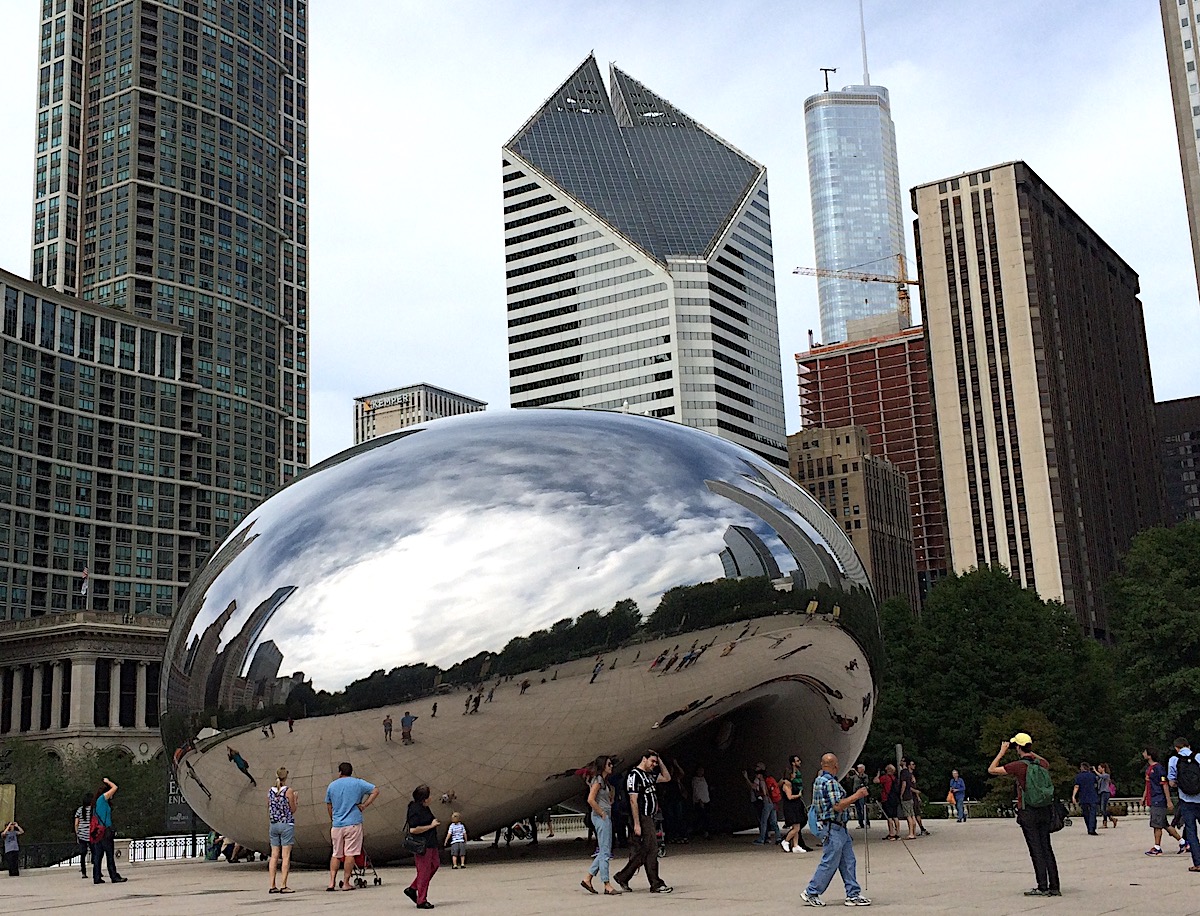 |
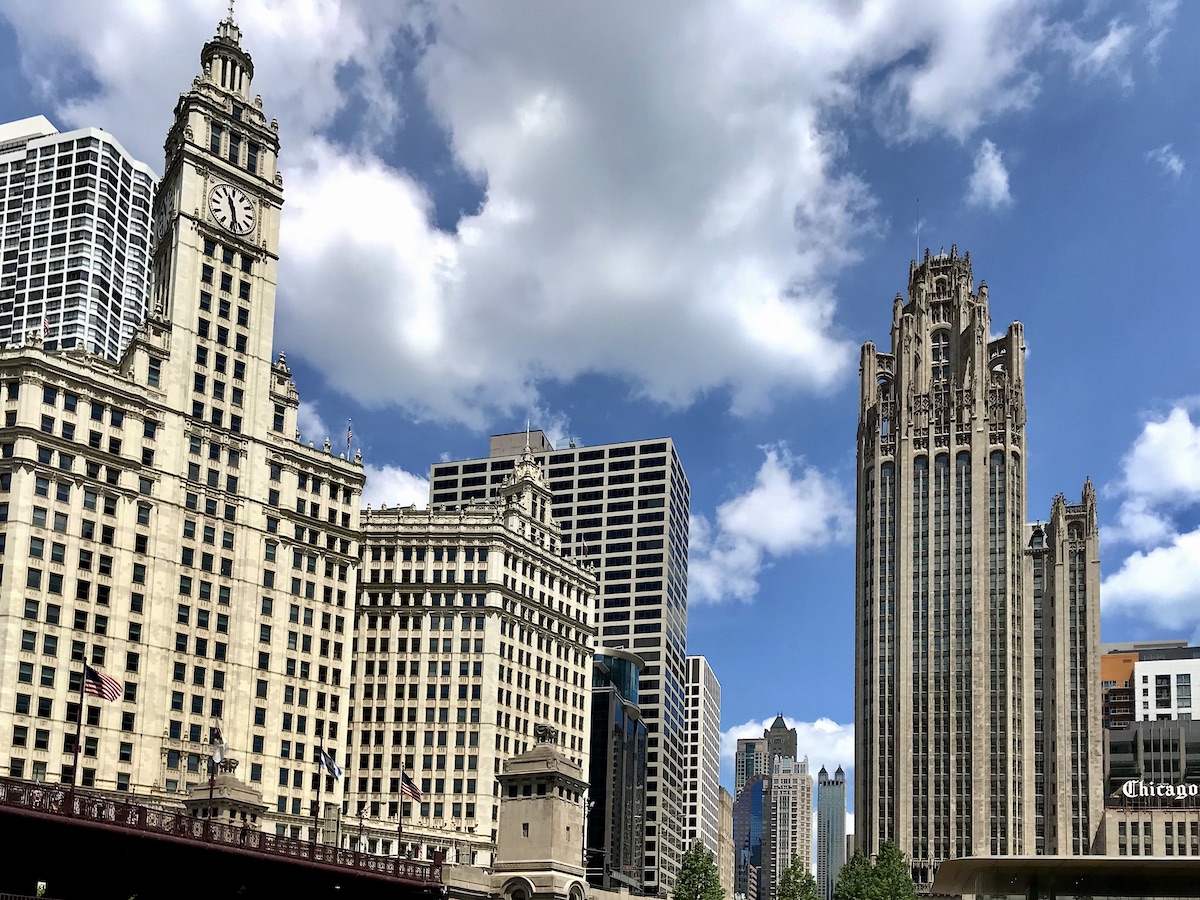 |
The city of Los Angeles, California, became the second most populous city in the United States in about 1980, but the city it surpassed – Chicago, Illinois – is still referred to as this country’s “Second City”.22 On the edge of Lake Michigan between the borders of Wisconsin and Indiana, Chicago long played a major role in the development of the Western expansion of the country. As ships were able to access the Great Lakes from the Atlantic, and once various locks and short connections of waterway were created, Chicago became a major port for world transportation providing direct access to the center of the Midwestern United States. The development of canals connecting Chicago to the Illinois River allows water transportation that circumnavigates from the Atlantic coast, to the Great Lakes, to the Mississippi River, to the Gulf of Mexico, and back to the Atlantic Ocean. And iron ore brought in from Lake Superior’s shores to Chicago helped pave the way for the steel industry, first for the railroads to the West, and soon for the automotive industry, to name a couple of examples. As a hub of major manufacturing and industry by the beginning of the 20th century, it should be no surprise that the development of slide rules in the U.S. has a strong history in the city of Chicago.
8.5.1 Early Chicago Slide Rules
While Keuffel and Esser of Hoboken, New Jersey, started their business in the 1870s, with mass production of slide rules starting in the mid-1890s, it wasn’t long before their operation expanded westward, with Chicago being first on their list for a new local office. Eugene Dietzgen was a K&E representative working out of Chicago who, in November 1885, teamed with Otto Luhring to start the company Luhring & Dietzgen in Chicago to sell and promote engineering supplies. Six years later in 1891, Dietzgen bought out the shares of Luhring and started Eugene Dietzgen and Company.
In 1898 Dietzgen acquired a patent that was granted to John Givan Davis Mack in that year, and Dietzgen soon entered the slide rule manufacturing arena. The “Mack Improved Mannheim Simplex Slide Rule” was a successful improvement to the general slide rule design, and was sold by Dietzgen from 1902 to 1912. By 1905 the Dietzgen Multiplex slide rule, with a scale layout patented by Leon Rosenthal, was introduced to compete with the K&E duplex slide rule. (See Scale Wars). Both rules could perform the multiplication of three numbers with one setting of the slide, thus improving the accuracy of the result. But the patented duplex (two-sided) rule was more expensive than the “simplex” (one-sided) Multiplex rule. The Multiplex rule used shorter scales to achieve its goal, and thus had a bit less accuracy for that reason, but it also made Dietzgen a serious competitor to K&E.
 |
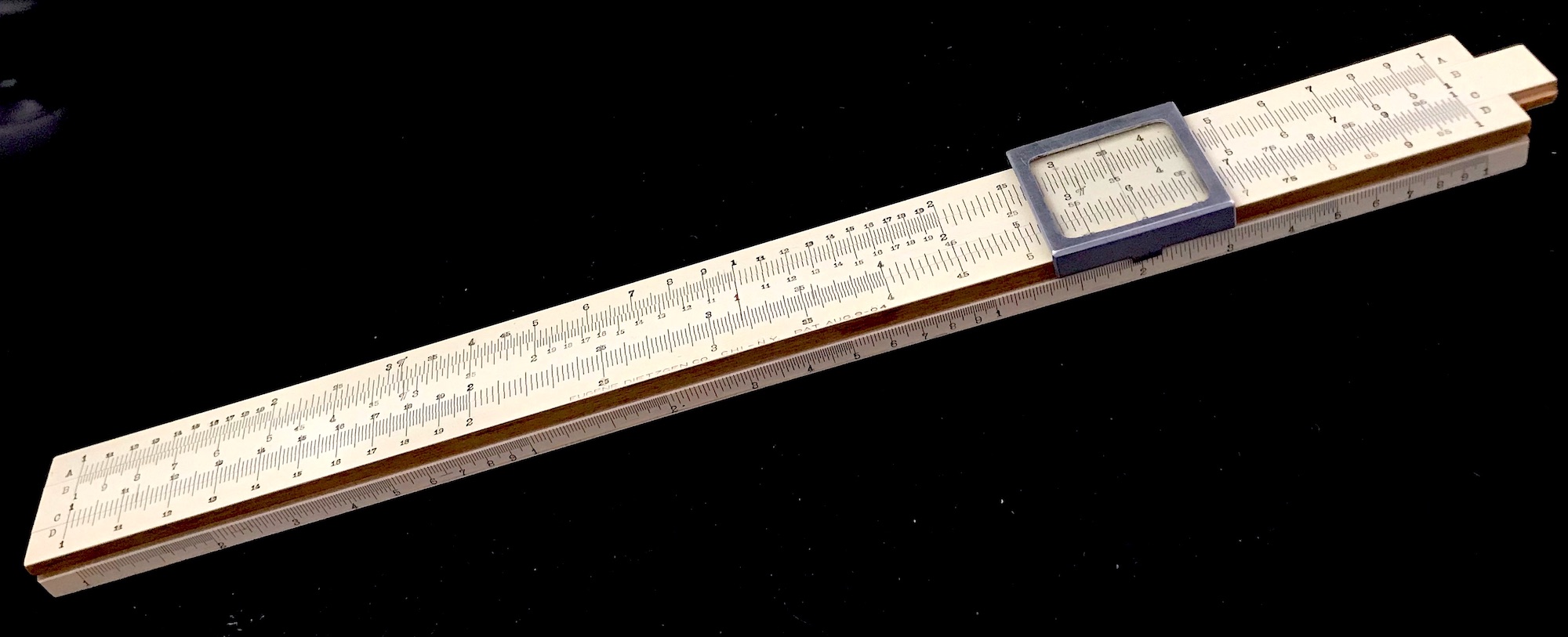 |
| Dietzgen Mack Improved | Dietzgen Multiplex |
While K&E had begun in the middle 1890s to manufacture their slide rules directly from their own timber from the Northeastern United States, Dietzgen acquired his materials from outside sources, primarily from Germany, but manufactured the final product in Chicago. Below are views of the building in Chicago once occupied by Eugene Dietzgen Co., with its signage still on the entrance today.

Also in the early 1900s another Chicago native, George Washington Richardson, began manufacturing slide rules in the basement of his home and advertising them in the magazine, Popular Mechanics. He was notable for his all-metal rules with special Gauge Marks for straightforward setup of specific calculations. He also had a very popular book, The Slide Rule Simplified. In 1919 his company was sold to Claire Gilson of Niles, Michigan. Located just 100 miles away, across Lake Michigan, Gilson was another maker of metal slide rules, though of the circular variety.
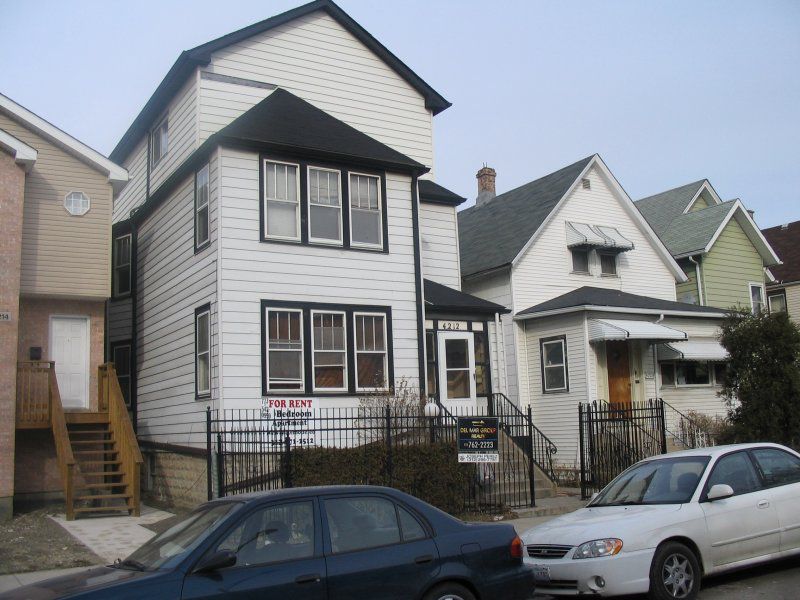 |
Present-day image of George W. Richardson’s home in Chicago. Photo courtesy of ISRM. See also the article by M. Konshak, Jour. Oughtred Soc. 15 1, p39 (2006). |

Other popular slide rule manufacturers from Chicago included Charles Bruning, J. B. Caroll, G. Felsenthal, The Lawrence Slide Rule Company (who started in Chicago before moving their operation to Indiana and becoming Lawrence Engineering Service), U.S. Blue, Co., and many others. There were also many industrial slide rule and slide chart makers in Chicago as well, such as CENCO, PERRYGRAF, Dyna-Slide, GraphicCalculator, Watham, Parisian, and so on. But in addition to Dietzgen, perhaps two other very popular companies for slide rules stand out: Frederick Post and Pickett.
8.5.2 Post and Pickett
The Frederick Post Company also was formed in Chicago in the late 1890s to manufacture and distribute engineering, surveying, and drafting instruments. Their facilities were just 4 miles away from Dietzgen’s building on the northwest side of Chicago. Post never manufactured their own slide rules. Their earliest slide rules, from about 1900, were made by German companies such as KHH until 1931, and then by Hemmi in Japan. During World War II, the United States being at war with both of these countries meant that Post had to procure slide rules from US companies, such as Roos, and then re-brand and sell under the Frederick Post Company name. Following the end of the war, Post went back to obtaining their slide rules from Hemmi in Japan which continued until 1975. They also sold occasional plastic slide rules made by Bruning, who was located nearby. Post was acquired by Teledyne in about 1970, after which the slide rules were labeled as “Teledyne Post”. More information can be found in Bob Otnes’ article from the Oughtred Society.
And then there was Pickett. Formally started as Pickett and Eckel right after the end of World War II in 1944, their original metal slide rules used magnesium to obtain a lighter device. However these slide rules had trouble with humidity and often became difficult to slide. Pickett began using aluminum alloys around 1950 and by 1964 had moved their headquarters to California. They became a very popular brand in the United States, especially with their “Eye-Saver” (ES) rules which have a characteristic yellow color. The various segmented log and log-log scales on the standard Picketts made them highly sought after. The high-quality metal pocket models such as the N600-ES Pickett slide rule was a popular choice for space flight during the U.S. space missions, leading up to and including the moon landings.
| Early Pickett 600 | Pickett N4-ES |
|---|---|
 |
 |
Throughout the 1950s, “the main players in the slide rule business were K&E, Dietzgen, Post, and Pickett,” according to Allan Boardman, a Pickett engineer during that period.23
8.5.3 The Versalog
But let’s go back to Post for a moment. The Post “Versalog” slide rule was one that was a highlight of many an engineer’s repertoire. This famous slide rule has an interesting history from beginning to end. Frederick Post set out to create a very high-quality slide rule that could span many engineering disciplines as part of its catalog. To do so, Post hired three engineering professors in 1950 from the nearby Illinois Institute of Technology, located in downtown Chicago: Profs. E.I. Fiesenheiser, B.S., MS., C.E., of the Civil Engineerinng Department, R.A. Budenholzer, B.S., hf.S., PH.D., of the Mechanical Engineering Department, and B.A. Fisher, B.S., M.S., E.E., of the Electrical Engineering Department. The three gentlemen worked together to help design a scale layout that would be versatile enough for use in the engineering problems of that time in each of the three engineering disciplines, and hopefully others. The slide rule would be manufactured by Hemmi and sold in the United States as the Versalog. The first Versalogs came off the assembly line in early 1951. The earliest one I have is from June of 1951, shown here:

Post remedied a problem they had with the less-than-adequate instructions that typically came from Japan with the Hemmi slide rules, by having the three professors write a book on the use and care of the new Versalog. The book that was created in 1951, The Versalog Slide Rule: An Instruction Manual, is a wonderful text that includes not only detailed instructions regarding the 23 scales on the slide rule, but also chapters on the specific use of the rule for each of the three engineering sub-disciplines, one chapter by each of the three contributors. The introductory material was written by Fiesenheiser.
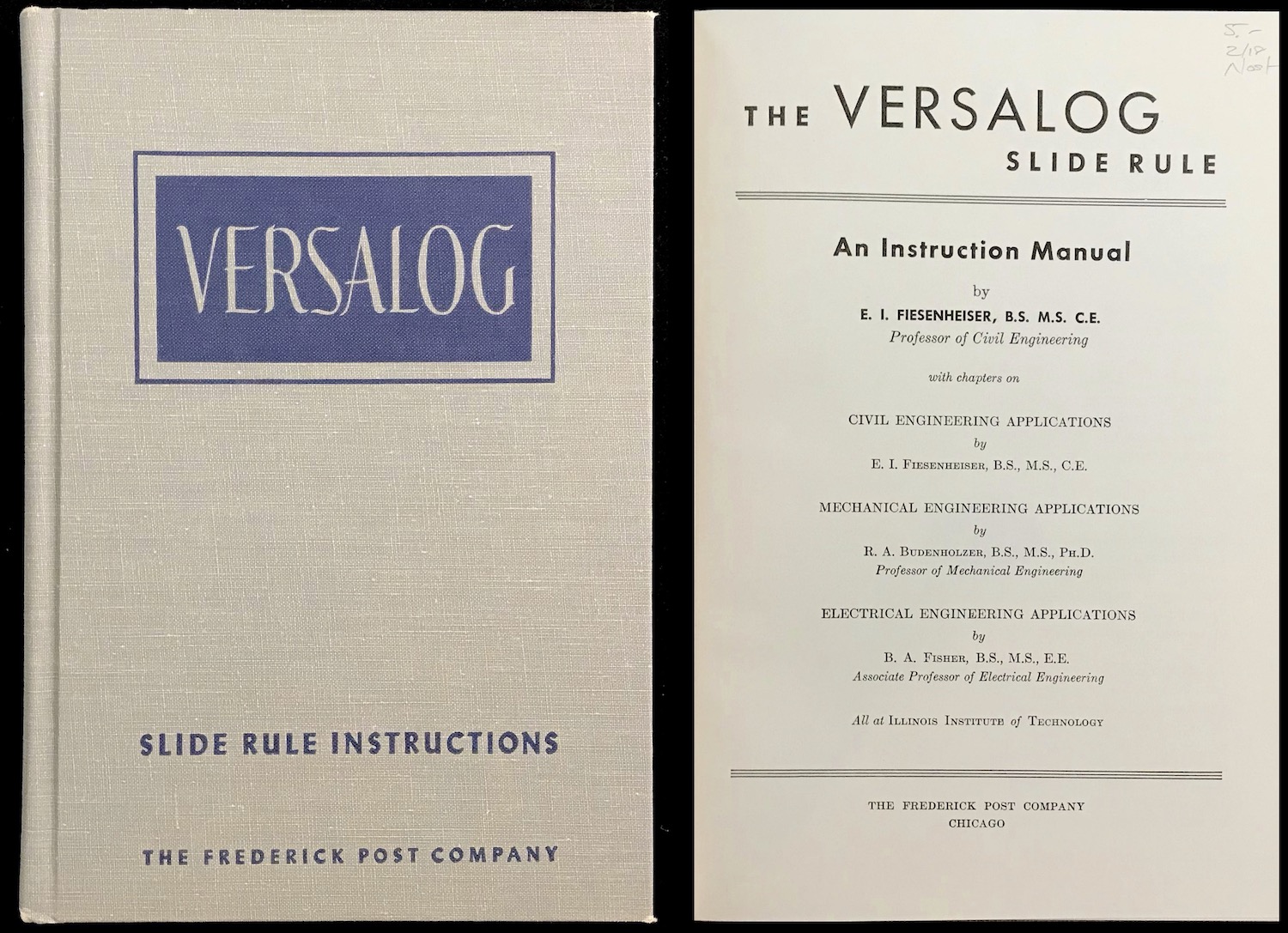
The early Versalogs were sold with a typical Hemmi box/container, but very soon Post began selling them with a distinct, high-quality, sewn-leather case, which came with a leather “belt loop”. On the front of the leather case, inside the flap, was a slot with a clear plastic panel within which one could place a business card or other identifying label.
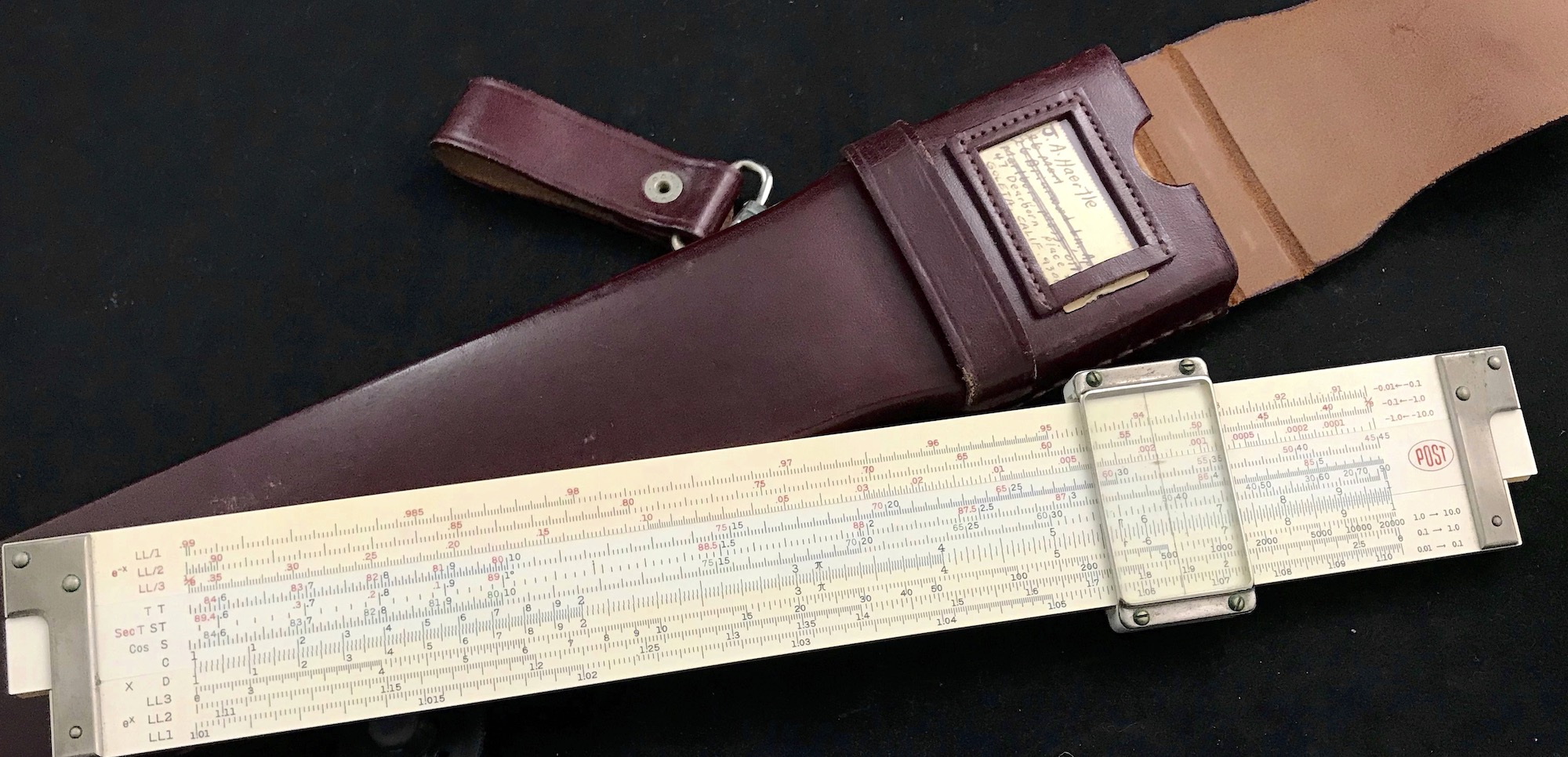
As an example, the Versalog shown above was made in 1966 (date code QH) and belonged to Mr. Joseph A. Haertle. Within the plastic window on the case, Haertle’s card has three addresses: 1) Marlboro, MA (window, top), 2) Goleta, CA (window, bottom), and 3) Clearwater, FL (back side of window tag). With this information I was able to find that Haertle
- received a B.S. in Physics/Math in 1962 and M.S. in Physics in 1968, both at Marquette University,
- co-authored a memorandum in 1969 while at Delco Systems Operations, in Goleta, CA,
- SUBJECT: TWO-MACHINE TESTING REPORT - 124; references to the Apollo program and testing of data against simulations in NASA’s Inertial Measurement Unit (IMU) tests,
- SUBJECT: TWO-MACHINE TESTING REPORT - 124; references to the Apollo program and testing of data against simulations in NASA’s Inertial Measurement Unit (IMU) tests,
- co-authored an overview article in 1984 entitled “Computer Modeling in New Vehicle Design”, in SAE Transactions, Vol. 93, Section 4,
- and, was associated with General Motors Corp. at this time.
It is hard to ascertain the exact timing of these addresses, but we have some other informative dates:
- Marlboro (Marlborough), MA – west of Boston, 11 mi from Framingham; location of the General Motors (GM) Framingham plant, which encompassed 176 acres. GM closed up shop on Aug. 1, 1989, but at its height GM’s Framingham Assembly plant was one of the largest industrial manufacturing facilities in the state of Massachusetts, employing 3,700 workers from all over New England.
- Goleta, CA – suburb of Santa Barbara; in 1962, GM created the General Motors Research Laboratories, based in Santa Barbara, California, to conduct research and development activities on defense systems. GM Motors Research Laboratories merged into Delco Electronics and was renamed Delco Systems Operations. The company was involved in developing early missile guidance systems during the Cold War, guidance systems for NASA’s Apollo lunar program, and systems engineering for the Apollo Lunar Roving Vehicle (LRV).
- In 1997, all of the aerospace and defense businesses of Hughes Electronics (Hughes Aircraft and Delco Systems Operations) merged with defense contractor Raytheon; the Hughes Network Systems portion of Hughes Communications became DirecTV; and the commercial portion of Delco Electronics was transferred to GM’s Delphi Automotive business.
- In 1997, all of the aerospace and defense businesses of Hughes Electronics (Hughes Aircraft and Delco Systems Operations) merged with defense contractor Raytheon; the Hughes Network Systems portion of Hughes Communications became DirecTV; and the commercial portion of Delco Electronics was transferred to GM’s Delphi Automotive business.
- Clearwater, FL – It is interesting to note that as of today Raytheon Technologies has facilities in the vicinity of the Florida address given on the Versalog.
My best guess is that Mr. Haertle was a GM employee who, as a young engineering physicist, was assigned to work on their portion of the Apollo program’s guidance system technologies in the late 1960s, and went on to perform computer simulations in the auto industry. Whatever the exact story, Haertle’s Versalog had quite the journey and no doubt saw a lot of action.
The Versalog was an immediate success in the engineering fields, and Post soon brought out a 5-inch “Pocket Versalog” to augment the standard 10-inch version. Its scales were the same as on the 10-inch model, but with half the number of graduations. By 1970, about the time that Post was acquired by Teledyne, a new improved version – the Versalog II – was commissioned. This model had a slight rearrangement of the scales – most notably the log-log scales – to improve numerical operations, and added an A scale to the rules (both 10-inch and 5-inch versions) bringing the total to 24 scales. While the original Versalog has the R1 and R2 scales which, in conjunction with D, can be used to find squares and square roots, the addition of a standard A scale made the use of the rule even more familiar for certain standard calculations, as well as providing more versatility for other calculations involving squares and square roots. Also included in this version:
- extension of the left end of the R2 scale
- addition of symbols (\(x\), \(x^2\), etc.) on the left end
- ranges of trig functions found on right end
- ST scale becomes SRT scale, for direct conversion of degrees to radians
- improved positioning of numerals on all trig scales
As the slide rule era was coming to an end at the time of the Versalog II, these rules with the A scale are more rare than the original Versalog, particularly the 5-inch pocket version.
| Versalog | Versalog II | ||
|---|---|---|---|
| 10-in |  |
 |
|
| 5-in | 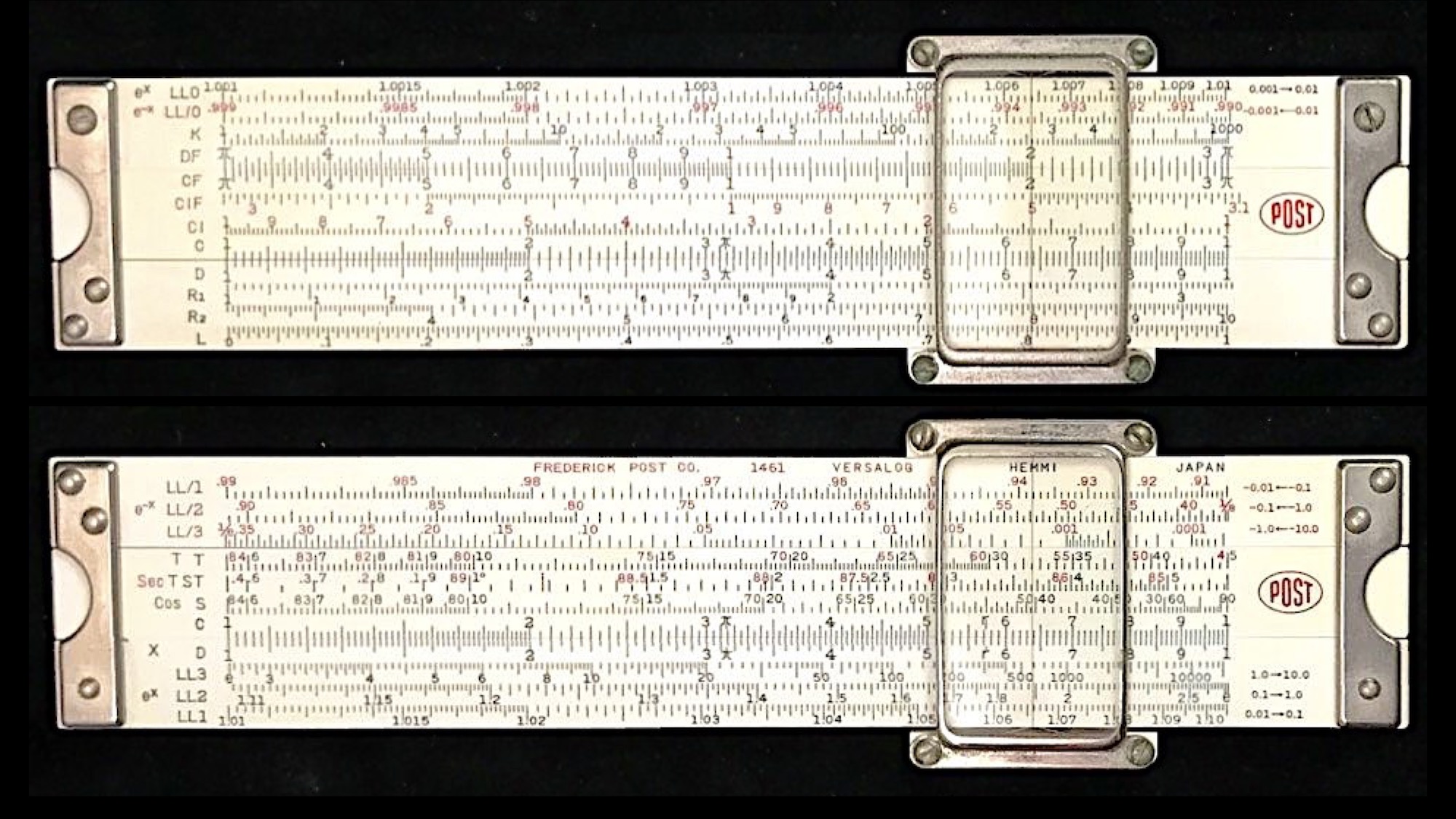 |
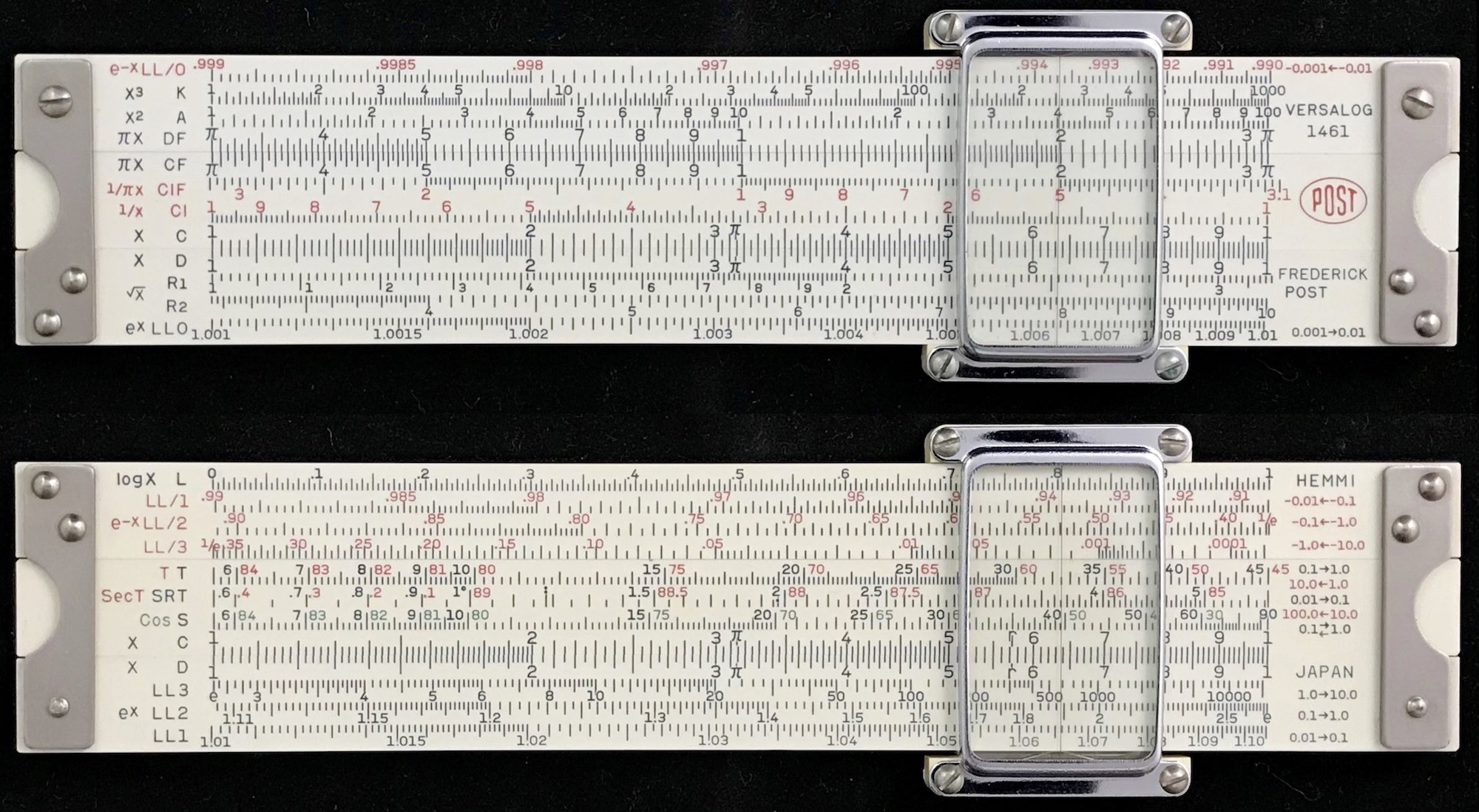 |
And, of course, with a new version came an updated instruction book: Versalog II Slide Rule Instruction Manual and Applied Text, by George John Zanotti, Teledyne Post, Chicago, 1970. Zanotti, working with the University of Illinois, re-wrote and modernized the introductory material, while the book retained the three “subject” chapters written by the original three IIT authors. The improved manual also included new text with examples and applications in business and general mathematics.
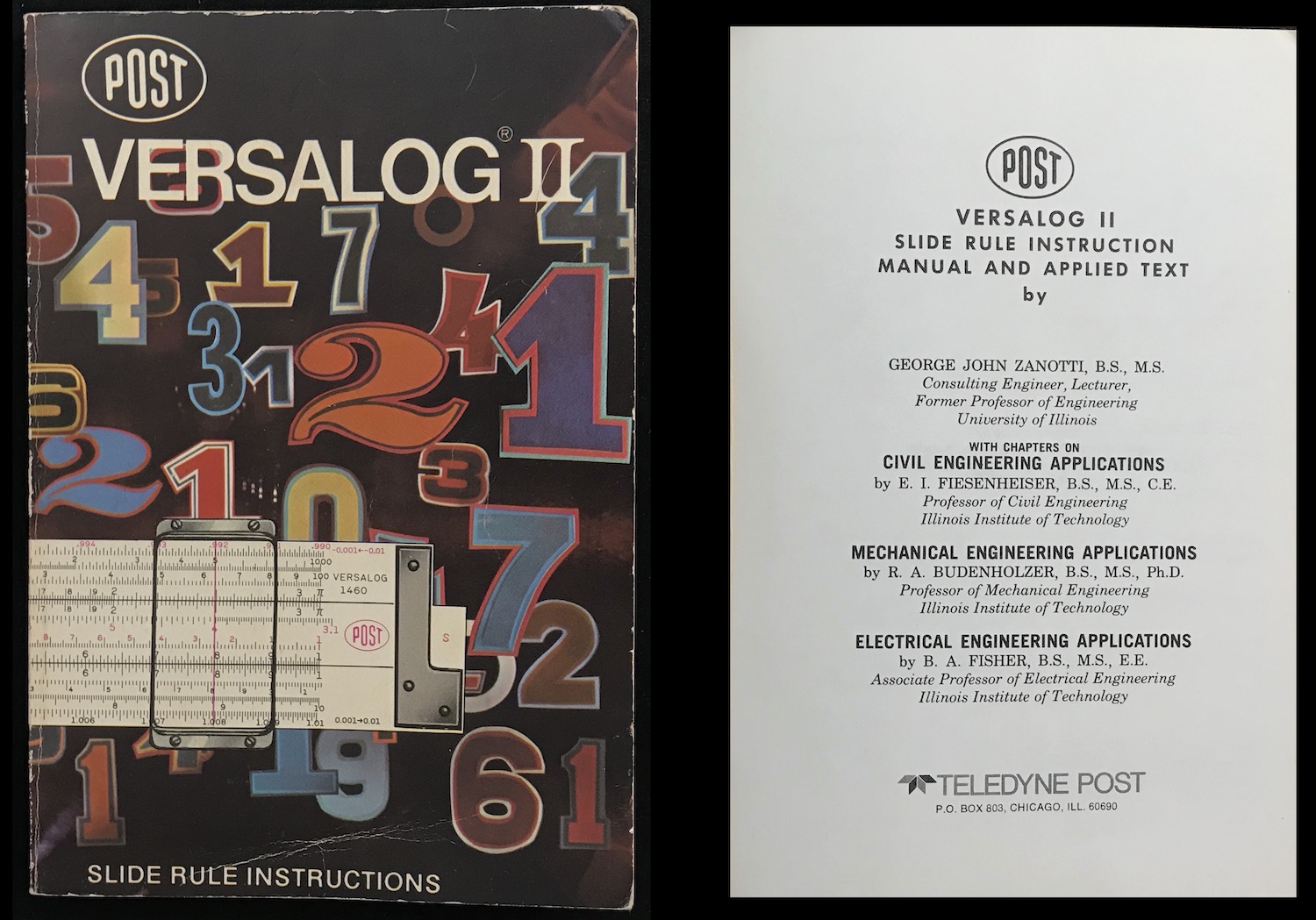
8.5.4 On the Map
By the middle of the 20th century, three of the top four slide rule producers in the United States had their origins in the city of Chicago. The number of individual companies that produced slide rules and slide sheets in the region is hard to enumerate but is noticeably large. And some of the most popular slide rules of modern engineers and scientists were developed by Chicago-based companies. From the Collection we can identify 156 slide rules that have a Chicago “connection”, which is roughly 59% of the number of US-made rules. Perhaps not too surprising for a collector located 43 miles west of the “epicenter”. But still, it is clear that the city of Chicago, Illinois, played a rather significant role in the modern development of slide rules in the U.S. and the world.
The map below shows the locations in Chicago and its surrounding area of significant slide rule manufacturers. Also shown are locations of major research universities, along with several major research centers including those in existence during the 1960s and 70s (in parentheses).
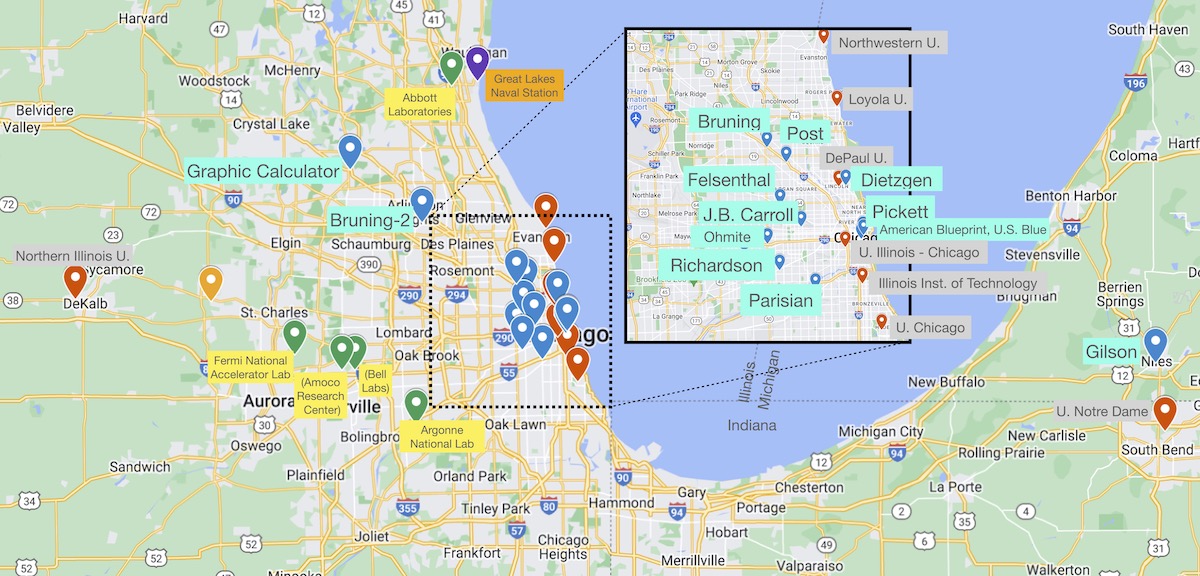
Some Chicago Area Rule Makers. (Map courtesy Google Maps.)
Side Note: It is often thought that perhaps Acu-Rule was a Chicago company at one point, as while they started out in Festus, Missouri, they later moved to Mount Olive, Illinois. However, Mount Olive is a suburb of St. Louis, Missouri, on the other side of the Mississippi River – over two hundred miles away from Chicago.
Besides once being second in population to New York City, Chicago burned to the ground in 1871 and was rebuilt from the ground up – built for the second time – using improved materials like steel rather than timber. In addition, a derogatory reference coined by New York native and travel author A.J. Liebling in 1890 made the coinage “Second City” a popular (to some) moniker for Chicago.↩︎
Allan Boardman, “Recollections of a Pickett Industries Employee”, JOS 16 2, p8 (2007).↩︎